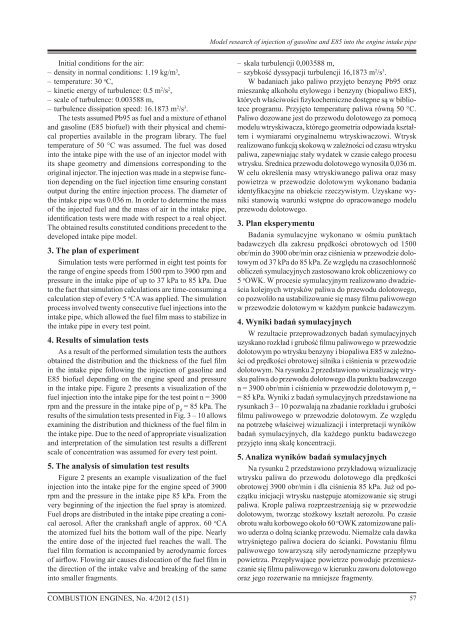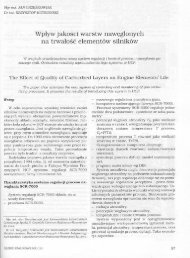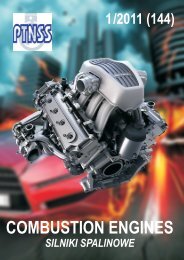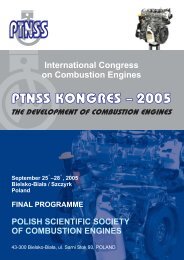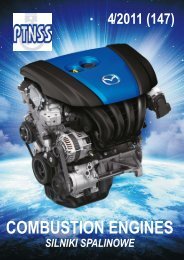You also want an ePaper? Increase the reach of your titles
YUMPU automatically turns print PDFs into web optimized ePapers that Google loves.
Model research of injection of gasoline and E85 into the engine intake pipe<br />
Initial conditions for the air:<br />
– density in normal conditions: 1.19 kg/m 3 ,<br />
– temperature: 30 o C,<br />
– kinetic energy of turbulence: 0.5 m 2 /s 2 ,<br />
– scale of turbulence: 0.003588 m,<br />
– turbulence dissipation speed: 16.1873 m 2 /s 3 .<br />
The tests assumed Pb95 as fuel and a mixture of ethanol<br />
and gasoline (E85 biofuel) with their physical and chemical<br />
properties available in the program library. The fuel<br />
temperature of 50 °C was assumed. The fuel was dosed<br />
into the intake pipe with the use of an injector model with<br />
its shape geometry and dimensions corresponding to the<br />
original injector. The injection was made in a stepwise function<br />
depending on the fuel injection time ensuring constant<br />
output during the entire injection process. The diameter of<br />
the intake pipe was 0.036 m. In order to determine the mass<br />
of the injected fuel and the mass of air in the intake pipe,<br />
identification tests were made with respect to a real object.<br />
The obtained results constituted conditions precedent to the<br />
developed intake pipe model.<br />
3. The plan of experiment<br />
Simulation tests were performed in eight test points for<br />
the range of engine speeds from 1500 rpm to 3900 rpm and<br />
pressure in the intake pipe of up to 37 kPa to 85 kPa. Due<br />
to the fact that simulation calculations are time-consuming a<br />
calculation step of every 5 o CA was applied. The simulation<br />
process involved twenty consecutive fuel injections into the<br />
intake pipe, which allowed the fuel film mass to stabilize in<br />
the intake pipe in every test point.<br />
4. Results of simulation tests<br />
As a result of the performed simulation tests the authors<br />
obtained the distribution and the thickness of the fuel film<br />
in the intake pipe following the injection of gasoline and<br />
E85 biofuel depending on the engine speed and pressure<br />
in the intake pipe. Figure 2 presents a visualization of the<br />
fuel injection into the intake pipe for the test point n = 3900<br />
rpm and the pressure in the intake pipe of p d<br />
= 85 kPa. The<br />
results of the simulation tests presented in Fig. 3 – 10 allows<br />
examining the distribution and thickness of the fuel film in<br />
the intake pipe. Due to the need of appropriate visualization<br />
and interpretation of the simulation test results a different<br />
scale of concentration was assumed for every test point.<br />
5. The analysis of simulation test results<br />
Figure 2 presents an example visualization of the fuel<br />
injection into the intake pipe for the engine speed of 3900<br />
rpm and the pressure in the intake pipe 85 kPa. From the<br />
very beginning of the injection the fuel spray is atomized.<br />
Fuel drops are distributed in the intake pipe creating a conical<br />
aerosol. After the crankshaft angle of approx. 60 o CA<br />
the atomized fuel hits the bottom wall of the pipe. Nearly<br />
the entire dose of the injected fuel reaches the wall. The<br />
fuel film formation is accompanied by aerodynamic forces<br />
of airflow. Flowing air causes dislocation of the fuel film in<br />
the direction of the intake valve and breaking of the same<br />
into smaller fragments.<br />
– skala turbulencji 0,003588 m,<br />
– szybkość dyssypacji turbulencji 16,1873 m 2 /s 3 .<br />
W badaniach jako paliwo przyjęto benzynę Pb95 oraz<br />
mieszankę alkoholu etylowego i benzyny (biopaliwo E85),<br />
których właściwości fizykochemiczne dostępne są w bibliotece<br />
programu. Przyjęto temperaturę paliwa równą 50 °C.<br />
Paliwo dozowane jest do przewodu dolotowego za pomocą<br />
modelu wtryskiwacza, którego geometria odpowiada kształtem<br />
i wymiarami oryginalnemu wtryskiwaczowi. Wtrysk<br />
realizowano funkcją skokową w zależności od czasu wtrysku<br />
paliwa, zapewniając stały wydatek w czasie całego procesu<br />
wtrysku. Średnica przewodu dolotowego wynosiła 0,036 m.<br />
W celu określenia masy wtryskiwanego paliwa oraz masy<br />
powietrza w przewodzie dolotowym wykonano badania<br />
identyfikacyjne na obiekcie rzeczywistym. Uzyskane wyniki<br />
stanowią warunki wstępne do opracowanego modelu<br />
przewodu dolotowego.<br />
3. Plan eksperymentu<br />
Badania symulacyjne wykonano w ośmiu punktach<br />
badawczych dla zakresu prędkości obrotowych od 1500<br />
obr/min do 3900 obr/min oraz ciśnienia w przewodzie dolotowym<br />
od 37 kPa do 85 kPa. Ze względu na czasochłonność<br />
obliczeń symulacyjnych zastosowano krok obliczeniowy co<br />
5 o OWK. W procesie symulacyjnym realizowano dwadzieścia<br />
kolejnych wtrysków paliwa do przewodu dolotowego,<br />
co pozwoliło na ustabilizowanie się masy filmu paliwowego<br />
w przewodzie dolotowym w każdym punkcie badawczym.<br />
4. Wyniki badań symulacyjnych<br />
W rezultacie przeprowadzonych badań symulacyjnych<br />
uzyskano rozkład i grubość filmu paliwowego w przewodzie<br />
dolotowym po wtrysku benzyny i biopaliwa E85 w zależności<br />
od prędkości obrotowej silnika i ciśnienia w przewodzie<br />
dolotowym. Na rysunku 2 przedstawiono wizualizację wtrysku<br />
paliwa do przewodu dolotowego dla punktu badawczego<br />
n = 3900 obr/min i ciśnienia w przewodzie dolotowym p d<br />
=<br />
= 85 kPa. Wyniki z badań symulacyjnych przedstawione na<br />
rysunkach 3 – 10 pozwalają na zbadanie rozkładu i grubości<br />
filmu paliwowego w przewodzie dolotowym. Ze względu<br />
na potrzebę właściwej wizualizacji i interpretacji wyników<br />
badań symulacyjnych, dla każdego punktu badawczego<br />
przyjęto inną skalę koncentracji.<br />
5. Analiza wyników badań symulacyjnych<br />
Na rysunku 2 przedstawiono przykładową wizualizację<br />
wtrysku paliwa do przewodu dolotowego dla prędkości<br />
obrotowej 3900 obr/min i dla ciśnienia 85 kPa. Już od początku<br />
inicjacji wtrysku następuje atomizowanie się strugi<br />
paliwa. Krople paliwa rozprzestrzeniają się w przewodzie<br />
dolotowym, tworząc stożkowy kształt aerozolu. Po czasie<br />
obrotu wału korbowego około 60 o OWK zatomizowane paliwo<br />
uderza o dolną ściankę przewodu. Niemalże cała dawka<br />
wtryśniętego paliwa dociera do ścianki. Powstaniu filmu<br />
paliwowego towarzyszą siły aerodynamiczne przepływu<br />
powietrza. Przepływające powietrze powoduje przemieszczanie<br />
się filmu paliwowego w kierunku zaworu dolotowego<br />
oraz jego rozerwanie na mniejsze fragmenty.<br />
<strong>COMBUSTION</strong> <strong>ENGINES</strong>, No. 4/2012 (151)<br />
57


